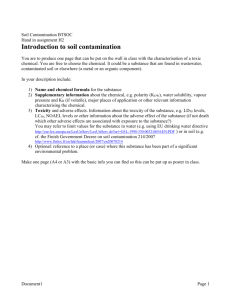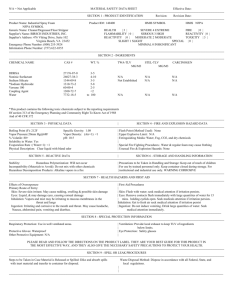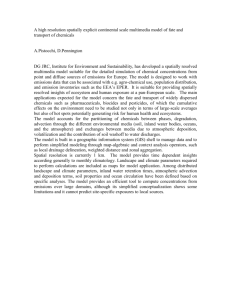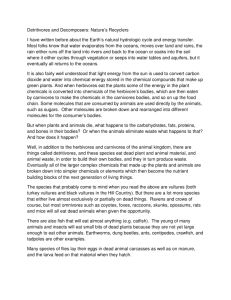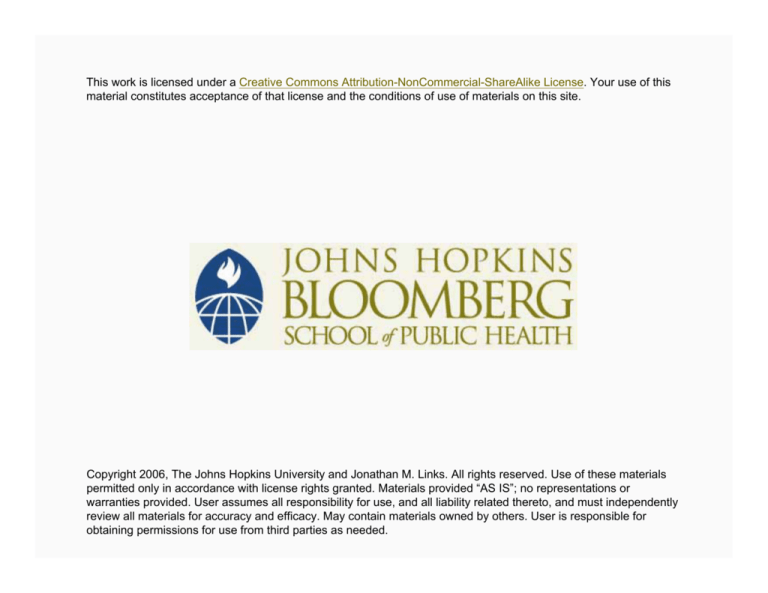
This work is licensed under a Creative Commons Attribution-NonCommercial-ShareAlike License. Your use of this
material constitutes acceptance of that license and the conditions of use of materials on this site.
Copyright 2006, The Johns Hopkins University and Jonathan M. Links. All rights reserved. Use of these materials
permitted only in accordance with license rights granted. Materials provided “AS IS”; no representations or
warranties provided. User assumes all responsibility for use, and all liability related thereto, and must independently
review all materials for accuracy and efficacy. May contain materials owned by others. User is responsible for
obtaining permissions for use from third parties as needed.
Introduction to Environmental Health
Jonathan M. Links, PhD
Johns Hopkins University
Section A
Objectives and Definitions
Course Learning Objectives
Define the major types, sources, and environmental
distribution of environmental agents
Describe how these agents interact with biological systems,
and describe the mechanisms by which they exert adverse
effects
Predict the nature of the agent’s adverse effects from its
physical, chemical, or infectious properties, and how that may
influence environmental or public health
4
Course Learning Objectives
Describe and use models for prediction of the magnitude of
adverse effects in biological systems
Identify significant gaps in the current knowledge base
concerning health effects of environmental agents, and areas
of uncertainty in the risk-assessment process
Describe current legislation and regulation regarding
environmental issues
5
Definitions: Environment
The circumstances, objects, or conditions by which one is
surrounded
or
The complex of climatic, edaphic (soil-based), and biotic
factors that act upon an organism or an ecologic community
6
Public Health Definition of “The Environment”
All that which is external to the individual host. [It] can be
divided into physical, biological, social, and cultural factors,
any or all of which can influence health status in populations.
− Last, J. M. (Ed.). (1995). A Dictionary of Epidemiology (3rd
ed.). New York: Oxford University Press.
7
Definitions: Health
The condition of being sound in body, mind, or spirit
A flourishing condition or well-being—not just the absence of
disease
or
8
Definitions: Health
A state of complete physical, mental, and social well-being
and not merely the absence of disease or infirmity
− WHO. (1948).
9
Definitions: Disease
Trouble or a condition of the living animal or plant body or
one of its parts that impairs the performance of a vital
function
10
Definitions: Safe
Free from harm or risk
Secure from threat of danger, harm, or loss
Zero risk
11
Definitions: Risk
Possibility of loss or injury, peril
The chance of loss; the degree of probability of such loss
12
What Is Environmental Health Sciences?
NIEHS charter: “The study of those factors in the environment
that affect human health”
− Factors (“pollutants” or “toxicants”) in air, water, soil, or
food
− Transferred to humans by inhalation, ingestion, or
absorption
− Production of adverse health effects
13
Contributors to the “Environment”
Chemical
− Air pollutants, toxic wastes, pesticides, VOCs
Biologic
− Disease organisms present in food and water
− Insect and animal allergens
Physical
− Noise, ionizing and non-ionizing radiation
Socioeconomic
− Access to safe and sufficient health care
14
WHO Definition of Environmental Health
Environmental health comprises those aspects of human
health, including quality of life, that are determined by
physical, biological, social, and psychosocial factors in the
environment. It also refers to the theory and practice of
assessing, correcting, controlling, and preventing those
factors in the environment that can potentially affect
adversely the health of present and future generations.
15
Facets of Environmental Health
Environmental epidemiology
− Associations between exposure to environmental agents
and subsequent development of disease
Environmental toxicology
− Causal mechanisms between exposure and subsequent
development of disease
Environmental engineering
− Factors that govern and reduce exposure
Preventive medicine
− Factors that govern and reduce disease development
Law
− Development of appropriate legislation to protect public
health
16
Section B
Environmental Health Issues
Question
Do you think that environmental issues are among the top
three public health issues in this country?
18
The “Right” First Question
What criteria do you use to identify an important public
health issue?
19
Traditional Public Health Approach
1.
2.
3.
4.
Define the problem
Identify and characterize the parameters governing the
problem
Design appropriate PH interventions
Implement and evaluate the interventions
20
Another Possible Approach
1.
2.
3.
4.
5.
Define the health parameters of importance
Identify the problems most impacting the health parameters
Identify and characterize the parameters governing the
problem
Design appropriate PH interventions
Implement and evaluate the interventions
21
Measure of Disease Burden and NIH Funding
Source: (1999). NEJM, 340, 1181.
Measure
(Year Assessed)
Units
Correlation
Coefficient ( r )
P Value
Incidence
(1990)
No. of new cases
per year
-0.05
0.82
Prevalence
(1990)
No. of existing
cases
0.25
0.23
Hospital days
(1994)
Days in acute care
hospitals
0.24
0.21
Mortality
(1994)
Deaths per year
0.40
0.03
Years of life lost
(1994)
Years
0.42
0.02
Disabilityadjusted lifeyears (1990)*
Years
0.62
< 0.001
Source: Adapted from (1999). NEJM, 340, 1181
*Loss of one year of healthy life to disease
22
Disability-Adjusted Life-Years and NIH Funding
Relationship between NIH disease-specific research funding
and disability-adjusted life-years
Source: Adapted from (1999). NEJM, 340, 1181.
23
Should You Care about EHS?
Acute environmental catastrophes (high-level exposures)
Chronic (low-level) exposures
Indirect effects of global environmental changes
24
The Wake-up Calls: Environmental Catastrophes
Minamata disease (1953–1961)
− Methyl mercury poisoning
Seveso, Italy (1976)
− Leak of toxic gas (TCDD)
Bhopal (1984)
− 16.5 tons of toxic pesticide released
25
The Wake-up Calls: Environmental Catastrophes
Chernobyl (1986)
− Nuclear reactor accident
Milwaukee incident (1993)
− Cryptosporidium in drinking water
26
Major Air Pollution Episodes
Date
Place
Xs Deaths
Dec. 1882
London, England
1,000
Dec. 1930
Meuse Valley,
Belgium
63
Oct. 1948
Donora, Penn.
20
Dec. 1952
London, England
Dec. 1962
Osaka, Japan
60
Jan. 1963
New York City
200–405
Nov. 1983
New York City
250
4,000
Excess deaths refers to the additional number of fatalities counted
above the number expected under otherwise normal conditions.
27
The London “Killer” Smog of 1952
Source: Adapted from Turco, R. P.
28
Chemicals in the Environment
Roughly 70,000 different synthetic chemicals are on the
global market; many others are emitted as by-products of
their production, use, or disposal
Production of synthetic organic chemicals (e.g., dyes, plastics,
solvents) has increased from less than 0.15 billion kilograms
(1935) to more than 150 billion kilograms (1995)
29
World Production of Synthetic Organic Chemicals
Millions of Kilograms
1000000
100000
10000
1000
100
1915
Data from Mitchell, J.D.
1935
1955
1975
1995
30
Substance-Specific Toxicity and Health Information
Substance-specific toxicity and health information (NRC/NAS,
1984)
100%
80%
compl HHE
60%
partial HHE
minimal
mim
toxtox
none
40%
20%
0%
meds
pest
food
cosm
chem
HHE = health hazard evaluation; meds = medications; pests = pesticides;
food = food additives; cosm = cosmetics; chem = commercial chemicals
31
Why Don’t We Know More about These Chemicals?
Number of chemicals (1984—NRC/NAS)
− Pesticides
3,350
− Drugs
1,815
− Cosmetics
3,410
− Food additives
8,627
32
Why Don’t We Know More about These Chemicals?
Chemicals in commerce (1984)
− >1 million lbs/yr
− <1 million lbs/yr
− Production unknown
12,860
13,911
21,752
33
Why Don’t We Know More about These Chemicals?
Each year ~1,000 new chemicals come on line
It costs ~ $ 2 million to do a cancer toxicology screen on each
chemical (NTP guidelines)
The cancer toxicology screen takes ~2 years
34
Routes of Exposure
Routes of exposure through gaseous, liquid, and solid media
Air
Lungs
Water
GI
Tract
GI
Tract
Skin
GI
Tract
Food
Skin
Soil
Adapted from Moeller, D.W.
35
Pollutant Source Pathways
Pollutant Source
Root Uptake
Soil Runoff
Air
Air
Concentration
Concentration
Water
Water
Concentration
Concentration
Soil
Ingestion
Soil
Ingestion
Water
Consumption
Inhalation
Inhalation
Soil
Soil
Concentration
Concentration
Plant
Plant
Concentration
Concentration
Plant
Consumption
Plant
Consumption
Cattle
Cattle && Poultry
Poultry
Concentration
Concentration
Fish
Fish
Concentration
Concentration
Fish
Consumption
Breast
Breast
Milk
Milk
Dermal
Exposure
Human Receptor
Adapted from Derelanko, M. J.
Egg and Poultry
Consumption
Dairy and Beef
Consumption
36
Environmental Pathways for Selected Toxic Agents
Agent
Disease
Source
Pathway
L.
pneumophila
Legionnaire’s
disease
Soil, cooling
towers
Air, building
ventilation
systems
Salmonella
Acute
diarrhea
Human or
animal feces
Water, meat,
eggs
Dioxin
Chloracne,
soft tissue
tumors
Herbicides,
paper mills,
incinerators
Air, water,
food
Pesticides
Nervous
system tox.
Agriculture
Food, water
Asbestos
Asbestosis,
lung cancer
Insulation,
auto brakes
Air, water
37
Agents and Vectors
Agents
− Chemical, biological, and physical
Vectors
− Water, air, soil, and food
Routes of entry
− Inhalation, ingestion, absorption
38
The Toxicological Paradigm
Exposure
Internal dose
Susceptibility
Genetic factors
Biologically effective dose
Early biologic effects
Effect modifiers
Diet
Habits
Health
Medication
Co-exposure
Altered structure and function
Clinical disease
39
The Toxicological Paradigm
Exposure
Internal dose
Susceptibility
Genetic factors
Biologically effective dose
Early biologic effects
Effect modifiers
Diet
Habits
Health
Medication
Co-exposure
Altered structure and function
Clinical disease
40
The Toxicological Paradigm
Exposure
Internal dose
Susceptibility
Genetic factors
Biologically effective dose
Early biologic effects
Effect modifiers
Diet
Habits
Health
Medication
Co-exposure
Altered structure and function
Clinical disease
41
Severity of Adverse Health Effects
Death
Significant disease
Manifest dysfunction
Clinical nuisance effects
Sub-clinical chronic alterations
Acute reversible (functional) effects
Population exposed
42
Health Effects
Adverse vs. beneficial
Acute vs. delayed onset
Clinical vs. subclinical manifestations
Transient (reversible) vs. chronic (irreversible)
43
Examples of Manifestations
Lung disease
Reproductive effects
Teratogenic effects
Neurologic effects
Immunosuppression and hypersensitivity
Cancer
44
Environment Pulls the Trigger
Environmental
Exposure
Intrinsic
Genetic
Human
Health/
Disease
Age/Time
“Genetics loads the gun,
but environment pulls
the trigger.”
— Judith Stern
UC Davis
45
Vulnerable Groups
Low socioeconomic status
Women
Children
Elderly
Ethnic minorities
Disabled
Indigenous peoples
All of whom are often more vulnerable because of—
− Genetics
− They are not empowered to change their environment
46
Section C
Problem Solving
Problem-Solving Paradigm: Six Steps
1.
2.
3.
4.
5.
6.
Define the problem
Measure its magnitude
Understand key determinants
Develop intervention/
prevention strategies
Set policy/priorities
Implement and evaluate
Risk assessment
Risk management
48
Selecting Priorities
Risk assessment
− The determination of the probability that an adverse
effect will result from a defined exposure
1. Hazard identification
2. Exposure assessment
3. Dose-response assessment
4. Risk characterization
− Pure “science” activities
49
Selecting Interventions
Risk management
− The process of weighing policy alternatives and selecting
the most appropriate regulatory actions based on the
results of risk assessment and social, economic, and
political concerns
50
Commonplace Risks Calculated
Commonplace risks calculated as number of deaths per
100,000 per year
Activity or Exposure
Risk/Year
Motorcycling
2,000
Smoking (all causes)
1,000
Hand gliding
80
Driving
24
Fires
2.8
4 TBS peanut butter per day
(aflatoxin)
0.8
Being struck by lightning
0.05
Being hit by a meteor
0.000006
51
Major Environmental Legislation
70
Number of Laws
60
50
40
30
20
10
0
1935
1945
1955
1965
1975
1985
1995
52
The Cost of Cleanup
The closer we get to the goal of zero emissions of a pollutant,
the more costly it becomes to eliminate each unit of pollution
53
The Cost of Cleanup
Reason
− First control method is usually the most effective and
easiest to implement, and produces the largest benefit at
the lowest cost
− Continued progress requires using more and more
expensive methods that remove smaller amounts of
pollutant
− At some point, costs outweigh benefits
54
The Law of Diminishing Returns
High
Pollution
Pollutant Emissions
10
8
6
4
2
0
Low
Pollution
1
3
5
7
9
11
13
15
17
19
21
Cost of Emission Controls ($ Million)
55
Societal Determinants
Human needs and wants drive choices that produce
environmental impacts which, in turn, may result in adverse
health consequences
56
Societal Determinants Flowchart
57
Factors
Factors influencing environmental health problems and
solutions
− Objective (technical/scientific)
− Subjective (non-scientific)
58
Examples of Technical/Scientific (“Objective”) Factors
Sources of agents
Measurement of environmental change
Toxicological process
Biological susceptibility
Engineering approaches
Human needs
59
Examples of Non-Scientific (“Subjective”) Factors
Human wants
Religious beliefs (“world view”; e.g., humankind vs. other
species and the planet)
Political systems
Economic systems
Societal values
Population dichotomies (e.g., rich vs. poor; developed vs.
developing countries)
60
Basic Requirements for a Healthy Environment
Clean air
Safe and sufficient water
Safe and adequate food
Safe and peaceful settlements
Stable global environment
Source: Yassi et al. (2001). UNEP.
61
Improving Human Health and Environment: 3 Models
62
Improving Human Health and Environment: 3 Models
Source: Adapted from Moeller, D. W.
63
Environmental Health Sciences
64
Key Points
EHS is the study of those factors in the environment that
affect human health
These factors represent chemical, biological, or physical
agents contained in air, water, soil, or food, and are
transported to humans via inhalation, ingestion, or skin
absorption
Adverse health effects may be acute or delayed in onset,
clinical or subclinical, and reversible or irreversible
65
Key Points
Environmental health sciences includes
− Environmental epidemiology and toxicology as the basis
of environmental health risk assessment
− Environmental engineering and regulation/risk
communication as the basis of environmental health risk
management
66


